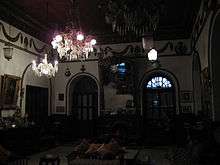Chunnamal Haveli


Lala Chunnamal ki Haveli (छुन्नामल की हवेली) is a rare haveli (old-style Indian courtyard mansion) surviving in a well-preserved condition within the old Delhi area.[1]
Background
In the mid-1800s, Lala Chunnamal was an extremely wealthy merchant based in Chandni Chowk, Old Delhi. His family belonged to the Khatri caste of Punjabi tradesmen and were staunch Hindus.
Treachery during war
During the Indian Rebellion of 1857, Lala Chunnamal emerged as one of the wealthiest men in Delhi, having astutely read which way the wind was blowing, and made a vast fortune supplying provisions to the British.[2] He had also refused a request for a loan from Emperor Bahadur Shah Zafar himself. Having refused the Emperor, he had left the city overnight after having previously sent much of his wealth out of the city secretly. After the hostilities ended, the British ordered the exile (forcible removal) of all Muslims from the city of Delhi. At this time, Lala Chunnamal made another fortune by purchasing the properties of the departing nobility at throwaway prices. These events were viewed with dismay by the cultured gentry of the city, and the poet Mirza Ghalib specifically mentioned the name of Lala Chunnamal while lamenting that men of low birth and less honour, like Chunnamal, were crowing and exulting in their glittering "illuminated mansions," while honourable men of old and noble families were "sifting the dirt" after being trampled down by the British.[3]
Saving a mosque
However, the tradesman was to prove the poet wrong in his estimation of the man. Among the properties which Lala Chunnamal acquired during this period was the Fatehpuri Masjid, a sprawling 17th century mosque built by one of the wives of Mughal emperor Shah Jehan, and located not far from Chunnamal's mansion in old Delhi. After the Muslims were expelled from the city in 1857, the mosque was deemed redundant, and was auctioned by the British with the intention that it be demolished and the land be used for building new houses and shops. Lala Chunnamal purchased the structure at auction for the massive sum of Rs. 19,000.[4][5] However, and to his eternal credit, Lala Chunnamal, a Hindu belonging to an orthodox, upper-caste family, did not demolish the mosque but preserved it. He did this in spite of the fact that there were no Muslims in the area who could pray in the mosque. He just kept the mosque locked up and waited, like a philosophical Hindu, for times to change.
Twenty years later, in 1877, the British lifted the prohibition against Muslims entering (or living in) Delhi. This was done at the time of the Delhi Darbar of 1877, when Queen Victoria was proclaimed Empress of India. At this time, the mosque was acquired by the British and made available to Muslims for prayer. Lala Chunnilal received an estate of four villages in exchange for the mosque. It is noteworthy that a similar mosque, Akbarabadi Masjid, built by another wife of Shah Jahan, did not survive under similar circumstances. That mosque had succumbed to British cannon fire during the battle and a very ruined structure had been auctioned later.[6][7]
The haveli
The prosperity of the family survived into the twentieth century. The family was involved in the venture to establish India's first textile mill.[8] Also, the Chunnamal family was the first in Delhi to acquire an automobile and a phone. Interestingly, the actress Simi Garewal was briefly married to Ravi Mohan, a scion of the Chunnamal family.[9]
Today, the ancestral haveli of the family, which stands in the heart of Old Delhi, is the last mansion to survive in a well-preserved condition. The mansion, known as Lala Chunnamal ki haveli, is located in the Katra Nil section of Chandni Chowk. It is spread over one acre of land, with 128 rooms built on three floors.[10] The mansion is surrounded by as many as 139 shops. An inscription on the wall of the mansion's drawing room states that it was built in 1848. However, some parts of it were added in 1864. The eighth generation of the Chunnamal family, headed by Anil Pershad, currently lives in the main residential portion of the mansion.
See also
References
- ↑ Two havelis
- ↑ Hakim's haveli haven for Afghan refugees
- ↑ The Last Mughal, The Fall of a Dynasty, Delhi 1857, William Dalrymple
- ↑ Fatehpuri Shahi Masjid - A mute witness to the travails of Dillee
- ↑ http://www.hinduonnet.com/thehindu/mp/2003/09/25/stories/2003092500260100.htm [Beyond the Wall]
- ↑ mosque whtm In memory of a pious Begum The Hindu, October 3, 2005.
- ↑ Baishali Adak (July 10, 2012). "A place suitable for a queen". Deccan Herald. Retrieved 2013-09-17.
- ↑ Information on Chunnamal
- ↑ Simi Garewal and Ravi Mohan Archived 2016-04-20 at the Wayback Machine.
- ↑ http://archive.gulfnews.com/articles/05/01/03/146271.html
External links
- Chunnamal Haveli on Wikimapia
- Anglo Sanskrit Victoria Jubilee High School
- Satellite picture by Google Maps
- Photos tagged with "Chunnamal" at Flickr
Coordinates: 28°39′03″N 77°13′59″E / 28.65075°N 77.23307°E